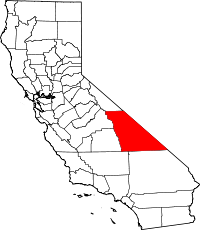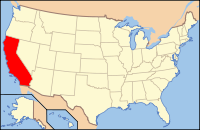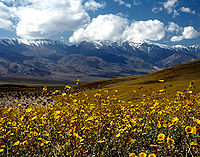- Inyo County, California
-
Coordinates: 36°35′N 117°25′W / 36.583°N 117.417°W
Inyo County, California Wildflowers blooming in Death Valley after an unusually wet winter
Seal
Location in the state of California
California's location in the U.S.Founded 1866 Named for "dwelling place of the great spirit" in Mono language Seat Independence Largest city Bishop Area
- Total
- Land
- Water
10,226.98 sq mi (26,488 km²)
10,203.10 sq mi (26,426 km²)
23.88 sq mi (62 km²), 0.23%Population
- (2010)
- Density
18,546
1.8/sq mi (1/km²)Congressional district 25th Time zone Pacific: UTC-8/-7 Website www.countyofinyo.org Inyo County is a county situated on the east side of the Sierra Nevada and southeast of Yosemite National Park in eastern-central part of the U.S. state of California. Inyo County includes the Owens River Valley; it is flanked on the east by the Sierra and by the White Mountains and the Inyo Mountains.
Mount Whitney, the highest peak in the Continental United States, is on Inyo County's western border (with Tulare County). The Badwater Basin, in Death Valley National Park, the lowest place in North America, is in eastern Inyo County. The two points are not visible from each other, but both can be observed from the Panamint Range on the west side of Death Valley, above the Panamint Valley.
The county seat is Independence. As of 2010 Inyo County had a population of 18,546.
Contents
History
Further information: Category:Native American history of CaliforniaPresent day Inyo county has been the historic homeland for thousands of years, of the Mono tribe, Coso people, Timbisha and Kawaiisu Native Americans. They spoke the Timbisha language and the Mono language; with Mono traditional narratives. The descendant of these ancestors continue to live in their traditional homelands in the Owens River Valley and in 'Death Valley National Park.
Inyo County was formed in 1866 from the territory of the unorganized Coso County created on April 4, 1864 from parts of Mono and Tulare Counties.[1] It acquired more territory from Mono County in 1870 and Kern County and San Bernardino County in 1872.
For many years it has been commonly believed that the county derived its name from the Mono tribe of Native Americans name for the mountains in its former homeland. Actually the name came to be thought of, mistakenly, as the name of the mountains to the east of the Owens Valley when the first whites there asked the local Paiutes what the name of the mountains to the east was.
The local Paiutes responded that that was the land of Inyo. They meant by this that those lands belonged to the Shoshone tribe headed by a man whose name was Inyo. Inyo was the name of the headman of the Panamint band of Paiute-Shoshone people at the time of contact when the first whites, the Manly expedition of 1849, wandered, lost, into Death Valley on their expedition to the gold fields of western California. The Owens Valley whites misunderstood the local Paiute and thought that Inyo was the name of the mountains, when actually it was the name of the chief, or headman, of the tribe that had those mountains as part of their homeland.
"Indian George," a fixture of many of the stories of early Death Valley days, was Inyo's son. Indian George's Shoshone name was "Bah-Vanda-Sa-Va-Nu-Kee," which means "The Boy Who Ran Away," a name he was given when he became terrified of the whites and their wheeled wagons and huge buffalo, none of which the Shoshone had ever seen before when they came wandering down Furnace Creek Wash in December 1849. In 1940, when Bah-vanda was around 100 years old, J.C. Boyles, a Panamint Shoshone who had become educated, came back to the Panamint valley and interviewed Bah-Vanda at length about the early days of his life, including the events of 1849, and it is in this interview that Bah-vanda refers to his father, Inyo. [The Desert Magazine, February, 1940]
In order to provide water needs for the growing City of Los Angeles, water was diverted from the Owens River into the Los Angeles Aqueduct in 1913. The Owens River Valley cultures and environments changed substantially. From the 1910s to 1930s the Los Angeles Department of Water and Power purchased much of the valley for water rights and control. In 1941 the Los Angeles Department of Water and Power extended the Los Angeles Aqueduct system further upriver into the Mono Basin.
Natural history
Inyo County is host to a number of natural superlatives. Among them are:
- Mount Whitney, the highest point in the United States outside of Alaska
- Badwater, in Death Valley, the lowest point in North America
- Methuselah, an ancient Bristlecone pine tree and one of the oldest living trees on Earth
- Owens Valley, the deepest valley on the American continents
- Two mountain ranges exceeding 14,000 feet (4,300 m) in elevation: The Sierra Nevada and the White Mountains
- Thirteen of California's fifteen peaks which exceed 14,000 feet (a Fourteener) in elevation; the isolated Mount Shasta in northern California, and White Mountain Peak in neighboring Mono County, are the only California 14ers not (at least partly) in Inyo County
- The largest escarpment in the United States, rising from the floor of Death Valley to the top of Telescope Peak in the Panamint Range
Geography
According to the 2000 census, the county has a total area of 10,226.98 square miles (26,487.8 km2), of which 10,203.10 square miles (26,425.9 km2) (or 99.77%) is land and 23.88 square miles (61.8 km2) (or 0.23%) is water.[2] It is the second-largest in California and the tenth-largest in the nation (excluding boroughs and census areas in Alaska).
Cities and towns
- Big Pine
- Bishop
- Cartago
- Darwin
- Deep Springs
- Dixon Lane-Meadow Creek
- Furnace Creek
- Homewood Canyon
- Independence
- Keeler
- Lone Pine
- Mesa
- Olancha
- Pearsonville
- Round Valley
- Shoshone
- Tecopa
- Valley Wells
- West Bishop
- Wilkerson
Adjacent counties

Mono County Esmeralda County, Nevada 
Tulare County and Fresno County 
Nye County, Nevada  Inyo County, California
Inyo County, California 

Kern County San Bernardino County Clark County, Nevada See also: List of counties bordering eight or more countiesNational protected areas
- Death Valley National Park (part)
- Inyo National Forest (part)
- Manzanar National Historic Site
Transportation Infrastructure
Major highways
 U.S. Route 6
U.S. Route 6 U.S. Route 395
U.S. Route 395 State Route 127
State Route 127 State Route 136
State Route 136 State Route 168
State Route 168 State Route 178
State Route 178 State Route 190
State Route 190
Public transportation
Eastern Sierra Transit Authority operates intercity bus service along U.S. 395, as well as local services in Bishop. Service extends south to Ridgecrest (Kern County) and north to Reno, Nevada.
Airports
Bishop Airport, Independence Airport, Lone Pine Airport and Shoshone Airport are general aviation airports located near their respective cities. Stovepipe Wells Airport and Furnace Creek Airport are located in Death Valley National Park.
Demographics
2010
The 2010 United States Census reported that Inyo County had a population of 18,546. The racial makeup of Inyo County was 13,741 (74.1%) White, 109 (0.6%) African American, 2,121 (11.4%) Native American, 243 (1.3%) Asian, 16 (0.1%) Pacific Islander, 1,676 (9.0%) from other races, and 640 (3.5%) from two or more races. Hispanic or Latino of any race were 3,597 persons (19.4%).[3]
Population reported at 2010 United States Census The County Total
PopulationWhite African
AmericanNative
AmericanAsian Pacific
Islanderother
racestwo or
more racesHispanic
or Latino
(of any race)Inyo County 18,546 13,741 109 2,121 243 16 1,676 640 3,597 Incorporated
cityTotal
PopulationWhite African
AmericanNative
AmericanAsian Pacific
Islanderother
racestwo or
more racesHispanic
or Latino
(of any race)Bishop 3,879 2,867 22 91 61 1 723 114 1,200 Census-designated
placeTotal
PopulationWhite African
AmericanNative
AmericanAsian Pacific
Islanderother
racestwo or
more racesHispanic
or Latino
(of any race)Big Pine 1,756 1,192 3 438 13 1 52 57 182 Cartago 92 63 0 7 0 0 11 11 16 Darwin 43 38 0 2 1 1 0 1 2 Dixon Lane-Meadow Creek 2,645 2,287 6 32 47 3 215 55 493 Furnace Creek 24 6 0 16 0 0 0 2 0 Homewood Canyon 44 37 0 0 0 0 5 2 6 Independence 669 493 6 98 8 1 28 35 93 Keeler 66 63 0 0 2 0 0 1 6 Lone Pine 2,035 1,334 6 205 17 1 376 96 694 Mesa 251 220 0 10 3 0 14 4 26 Olancha 192 133 0 4 8 0 38 9 47 Pearsonville 17 16 0 0 0 0 1 0 1 Round Valley 435 333 38 21 3 0 27 13 69 Shoshone 31 28 1 1 0 0 0 1 0 Tecopa 150 119 1 8 2 0 1 19 8 Trona 18 18 0 0 0 0 0 0 0 Valley Wells 0 0 0 0 0 0 0 0 0 West Bishop 2,607 2,373 10 28 45 1 72 78 261 Wilkerson 563 524 0 13 5 1 5 15 53 Unincorporated
communitiesTotal
PopulationWhite African
AmericanNative
AmericanAsian Pacific
Islanderother
racestwo or
more racesHispanic
or Latino
(of any race)All others not CDPs (combined) 3,029 1,597 16 1,147 28 6 108 127 440 2000
Historical populations Census Pop. %± 1870 1,956 — 1880 2,928 49.7% 1890 3,544 21.0% 1900 4,377 23.5% 1910 6,974 59.3% 1920 7,031 0.8% 1930 6,555 −6.8% 1940 7,625 16.3% 1950 11,658 52.9% 1960 11,684 0.2% 1970 15,571 33.3% 1980 17,895 14.9% 1990 18,281 2.2% 2000 17,945 −1.8% 2010 18,546 3.3% [4][5][6] As of the census[7] of 2000, there were 17,945 people, 7,703 households, and 4,937 families residing in the county. The population density was 2 people per square mile (1/km²). There were 9,042 housing units at an average density of 1 per square mile (0/km²). The racial makeup of the county was 80.06% White, 0.16% Black or African American, 10.04% Native American, 0.91% Asian, 0.08% Pacific Islander, 4.60% from other races, and 4.15% from two or more races. 12.58% of the population were Hispanic or Latino of any race. 16.4% were of German, 12.2% English, 10.6% Irish and 5.0% American ancestry according to Census 2000. 89.2% spoke English and 9.3% Spanish as their first language.
There were 7,703 households out of which 27.9% had children under the age of 18 living with them, 49.8% were married couples living together, 9.9% had a female householder with no husband present, and 35.9% were non-families. 31.4% of all households were made up of individuals and 13.6% had someone living alone who was 65 years of age or older. The average household size was 2.31 and the average family size was 2.88.
In the county the population was spread out with 24.4% under the age of 18, 5.80% from 18 to 24, 23.4% from 25 to 44, 27.3% from 45 to 64, and 19.1% who were 65 years of age or older. The median age was 43 years. For every 100 females there were 95.4 males. For every 100 females age 18 and over, there were 92.9 males.
The median income for a household in the county was $35,006, and the median income for a family was $44,970. Males had a median income of $37,270 versus $25,549 for females. The per capita income for the county was $19,639. About 9.30% of families and 12.60% of the population were below the poverty line, including 16.00% of those under age 18 and 8.30% of those age 65 or over.
Politics
Inyo County vote
by party in presidential electionsYear GOP DEM Others 2008 53.1% 4,523 43.9% 3,743 2.9% 243 2004 59.1% 5,091 38.9% 3,350 2.0% 175 2000 60.3% 4,713 33.9% 2,652 5.8% 450 1996 51.8% 3,924 34.4% 2,601 13.8% 1,044 1992 43.6% 3,689 31.8% 2,695 24.6% 2,080 1988 64.3% 5,042 33.9% 2,653 1.8% 142 1984 70.3% 5,863 28.3% 2,360 1.4% 115 1980 64.8% 5,201 25.9% 2,080 9.3% 746 1976 58.2% 3,905 39.3% 2,635 2.5% 166 1972 68.1% 4,873 28.0% 2,006 3.9% 280 1968 54.5% 3,641 34.6% 2,314 11.0% 732 1964 46.5% 2,751 53.4% 3,161 0.1% 3 1960 54.7% 2,962 45.1% 2,443 0.3% 15 1956 66.2% 3,524 33.5% 1,782 0.3% 18 1952 68.9% 3,819 30.6% 1,698 0.5% 28 1948 55.8% 2,135 40.2% 1,539 4.0% 153 1944 50.6% 1,699 49.1% 1,647 0.3% 9 1940 44.5% 1,483 54.7% 1,820 0.8% 27 1936 36.5% 912 62.4% 1,560 1.2% 29 1932 30.9% 698 64.6% 1,459 4.5% 101 1928 57.4% 1,206 41.0% 861 1.7% 35 1924 47.5% 950 12.8% 256 39.7% 793 1920 57.2% 1,195 32.7% 682 8.8% 212 Inyo is a strongly Republican county in Presidential and congressional elections. The last Democrat to win a majority in the county was Lyndon Johnson in 1964.
Inyo is part of California's 25th congressional district, which is held by Republican Buck McKeon. In the state legislature, Inyo is part of the 34th Assembly district, which is held by Republican Connie Conway, and the 18th Senate district, which is held by Republican Jean Fuller.
On Nov. 4, 2008 Inyo County voted 60.4 % for Proposition 8 which amended the California Constitution to ban same-sex marriages.
Education
School districts in Inyo County are:
- Bishop Union Elementary School District
- Bishop Joint Union High School District
- Big Pine Unified School District
- Lone Pine Unified School District
- Owens Valley Unified School District
- Round Valley School District
- Death Valley Unified School District
Notable locations
- Mushroom Rock
- Five Bridges
Lakes
- Weir Lake
- Camp Lake
- Inconsolable Lake
- Cottonwood Lakes
- Wishbone Lake
- Rock Creek Lake
- Granite Lake
- Robinson Lake
Parks and open space
- Alabama Hills Recreation Area
- Manzanar National Historic Site
- Death Valley National Park
- Last Chance Meadow Research Natural Area
- California Bighorn Sheep Zoological Area
Death Valley National Park
Death Valley National Park is a mostly arid United States National Park located east of the Sierra Nevada mountain range in southern Inyo County and northern San Bernardino County in California, with a small extension into southwestern Nye County and extreme southern Esmeralda County in Nevada. In addition, there is an exclave (Devil's Hole) in southern Nye County. The park covers 5,262 square miles (13,630 km2), encompassing Saline Valley, a large part of Panamint Valley, almost all of Death Valley, and parts of several mountain ranges.[8] Death Valley National Monument was proclaimed in 1933, placing the area under federal protection. In 1994, the monument was redesignated a national park, as well as being substantially expanded to include Saline and Eureka Valleys.[8]
It is the hottest and driest of the national parks in the United States. It also features the second-lowest point in the Western Hemisphere and the lowest point in North America at Badwater, which is 282 feet (86 m) below sea level. It is home to many species of plants and animals that have adapted to this harsh desert environment. Some examples include Creosote Bush, Bighorn Sheep, Coyote, and the Death Valley Pupfish, a survivor of much wetter times. Approximately 95% of the park is designated as wilderness.[9] Death Valley National Park is visited annually by more than 770,000 visitors who come to enjoy its diverse geologic features, desert wildlife, historic sites, scenery, clear night skies and the solitude of the extreme desert environment.
See also
References
- ^ "California, Theodore Henry Hittell, '''The general laws of the State of California, from 1850 to 1864''', H.H. Bancroft, San Francisco, 1865. p.190". Books.google.com. http://books.google.com/books?pg=PA190&lpg=PA186&dq=unorganized+%22Coso+%22&sig=wfIuzfhEgKgT4hlPxk4xC6GEcfs&ei=fG0gS82kEJPQtgOEubGQBQ&ct=result&id=99Y3AAAAIAAJ&ots=CmNPFn8eUm#v=onepage&q=unorganized%20%22Coso%20%22&f=false. Retrieved 2011-11-05.
- ^ "Census 2000 U.S. Gazetteer Files: Counties". United States Census. http://www.census.gov/tiger/tms/gazetteer/county2k.txt. Retrieved 2011-02-13.
- ^ "2010 Census P.L. 94-171 Summary File Data". United States Census Bureau. http://www2.census.gov/census_2010/01-Redistricting_File--PL_94-171/California/.
- ^ http://www.census.gov/population/www/censusdata/cencounts/files/ca190090.txt
- ^ "American FactFinder". Factfinder2.census.gov. http://factfinder2.census.gov. Retrieved 2011-11-05.
- ^ "University of Virginia Library". Mapserver.lib.virginia.edu. http://mapserver.lib.virginia.edu/. Retrieved 2011-11-05.
- ^ "American FactFinder". United States Census Bureau. http://factfinder.census.gov. Retrieved 2008-01-31.
- ^ a b National Park Index (2001–2003), p. 26
- ^ NPS website, "Backcountry Roads"
External links
Municipalities and communities of Inyo County, California City CDPs Big Pine | Cartago | Darwin | Dixon Lane-Meadow Creek | Furnace Creek | Homewood Canyon | Independence | Keeler | Lone Pine | Mesa | Olancha | Pearsonville | Round Valley | Shoshone | Tecopa | Trona | Valley Wells | West Bishop | Wilkerson
Unincorporated
communitiesAberdeen | Alabama Hills | Alico | Alta Vista | Ashford Junction | Aspendell | Badwater | Ballarat | Bartlett | Beatty Junction | Beveridge | Blackrock | Brockmans Corner | Calvada Springs | Coso | Coso Junction | Crater | Death Valley Junction | Deep Springs | Dolomite | Dunmovin | Evelyn | Fish Springs | Grant | Haiwee | Harrisburg | Homewood Canyon-Valley Wells | Indian Village | Junction Ranch | Kearsarge | Keough Hot Springs | Laws | Linnie | Little Lake | Millspaugh | Mock | Monola | Oteys Sierra Village | Owenyo | Panamint Springs | Park Village | Peterson Mill | Poleta | Reward | Rocking K | Rovana | Ryan | Scheelite | Scranton | Seven Pines | Stovepipe Wells | Sykes | Talus | Teakettle Junction | Whitney Portal | Zurich
Indian
reservationsBig Pine Reservation | Lone Pine Reservation
Ghost towns Ashford Mill | Avena | Bend City | Bradford Siding | Burnt Wagons | Carthage | Cerro Gordo Landing | Chloride City | Chrysopolis | Clark | Copperfield | Coso | Echo | Elna | Furnace | Furnace Creek Inn | Greenwater | Grestley | Horton | Intake | Jay | Kasson | Kearsarge | Lane Mill | Leadfield | Lee | Lila C | Lone Pine Station | Lookout City | Manzanar | Narka | Newburyport | Nine Mile Station | Noonday Camp | Owensville | Panamint | Reilly | San Carlos | Schwaub | Skidoo | Skyes | Sodan | Stewarts | Sunland | Swansea | Tule Station | White Mountain City
Categories:- California counties
- Inyo County, California
- Metropolitan areas of California
Wikimedia Foundation. 2010.




